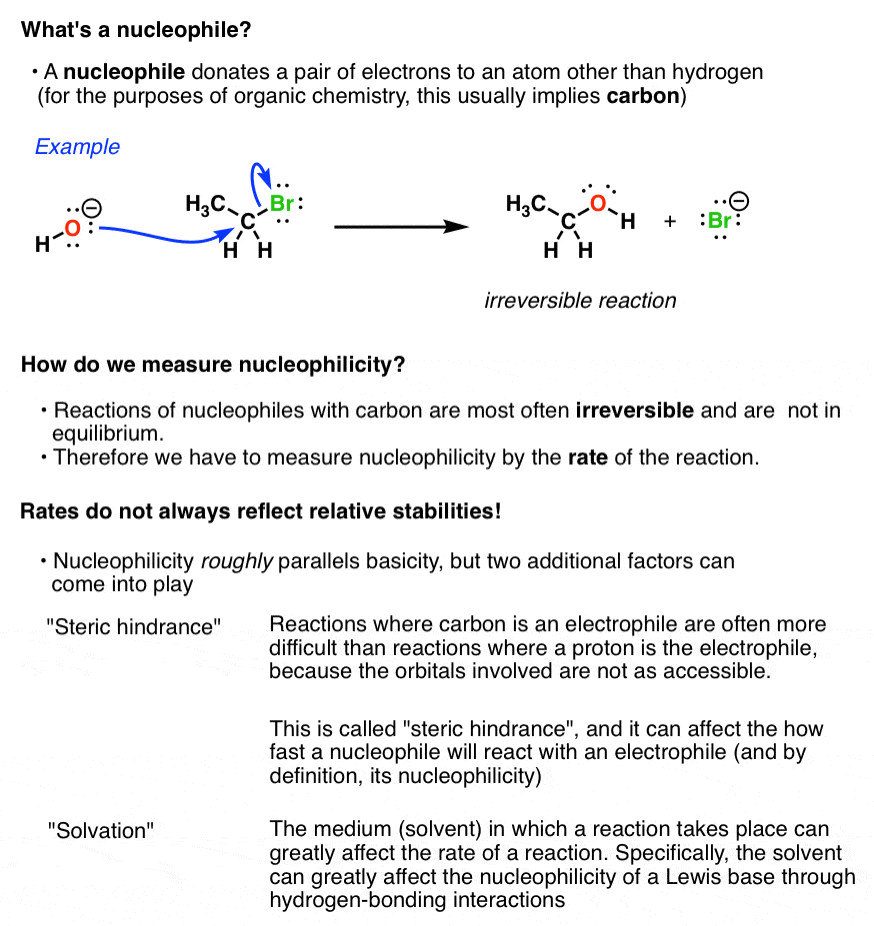Understanding The Differences Between Nucleophilicity vs Basicity
Following up on Nucleophiles and Electrophiles, here’s a common question students have about nucleophilicity:
1. What’s the difference between nucleophilicity and basicity?
Great, great question.
First of all, remember that basicity is a subset of nucleophilicity. All nucleophiles are Lewis bases; they donate a lone pair of electrons. A “base” (or, “Brønsted base”) is just the name we give to a nucleophile when it’s forming a bond to a proton (H+). To summarize, when we’re talking about basicity and nucleophilicity, we’re talking about these two types of events.
- Basicity: nucleophile attacks hydrogen
- Nucleophilicity: nucleophile attacks any atom other than hydrogen. Because we’re talking about organic chemistry here, for our purposes, this is going to mean “carbon” most of the time.
2. Nucleophilicity vs Basicity: What Is A Base?
So how do reactions of nucleophiles at hydrogen differ from reactions of nucleophiles at carbon? Well, they’re more easily reversible, for one thing. We can measure acidity (and, by extension, basicity) through the measure known as pKa, which is a reflection of the position of the equilibrium between an acid and its conjugate base.
Let’s put it up in a graphic:

Because we can measure the equilibrium constants for reversible acid-base reactions, we can get a fairly good idea of the relative strengths of acids and bases. There’s some complications; solvent effects can play a role in stabilities, for instance* but overall, the pKa table is our friend. It’s a great “reactivity ladder” to hang our hats on.
We talked about what made species strong bases a few posts ago – it’s here. The bottom line is that the more unstable a lone pair of electrons is, the more basic it will be (and vice versa).
3. Nucleophilicity vs Basicity: What Is A Nucleophile?
And then there’s nucleophilicity. How is nucleophilicity different from basicity? Well, since it’s not limited to simply forming a bond to hydrogen anymore, this leads to some extra complications. Let’s just talk about the measurement problem first.
Many reactions of nucleophiles are not reversible. A bond forms, a bond breaks, and that’s the end of the reaction. The problem with this from a measurement standpoint is that we often can’t determine an equilibrium constant for a reaction. And if we can’t do that, then we can’t develop a reactivity scale based on equilibria.
If we can’t measure equilibria, then what do we do? Well, we use the next best measurement available: to measure reaction rates.
There’s one important thing to remember with reaction rates. They don’t always reflect overall stability. There are a few more variables at play here.
- Factor #1: Steric hindrance. Reactions where nucleophiles attack carbon-based electrophiles are significantly more sensitive to steric effects, because empty orbitals on carbon are not as accessible. Steric hindrance is like a fat goalie.
- Factor #2: Solvents. The medium (solvent) in which a reaction takes place can greatly affect the rate of a reaction. Specifically, the solvent can greatly attenuate (reduce) the nucleophilicity of some Lewis bases through hydrogen bonding.
Again, let’s go to the graphic:

Here’s another question that comes up. How do you know when something is going to act as a base, and when it’s going to act as a nucleophile? Another great question!
Like the prototypical three-handed economist, I’ll tell you that it depends upon what type of reaction you’re talking about. Acid-base reactions tend to be fast, relatively speaking. But it will greatly depend on the situation. More soon, I assure you.
Next: So what, specifically, makes something a good nucleophile?
